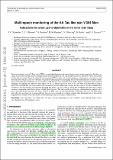Files in this item
Multi-epoch monitoring of the AA Tauri-like star V354 Mon. Indications for a low gas-to-dust ratio in the inner disk warp
Item metadata
| dc.contributor.author | Schneider, P. C. | |
| dc.contributor.author | Manara, C. F. | |
| dc.contributor.author | Facchini, S. | |
| dc.contributor.author | Guenther, H. M. | |
| dc.contributor.author | Herczeg, G. J. | |
| dc.contributor.author | Fedele, D. | |
| dc.contributor.author | Teixeira, P. S. | |
| dc.date.accessioned | 2018-07-13T14:30:05Z | |
| dc.date.available | 2018-07-13T14:30:05Z | |
| dc.date.issued | 2018-06-28 | |
| dc.identifier | 254747049 | |
| dc.identifier | 39c2d817-e9fe-4c97-8f16-994bde12595f | |
| dc.identifier | 000436902800001 | |
| dc.identifier | 85049558831 | |
| dc.identifier | 000436902800001 | |
| dc.identifier.citation | Schneider , P C , Manara , C F , Facchini , S , Guenther , H M , Herczeg , G J , Fedele , D & Teixeira , P S 2018 , ' Multi-epoch monitoring of the AA Tauri-like star V354 Mon. Indications for a low gas-to-dust ratio in the inner disk warp ' , Astronomy & Astrophysics , vol. 614 , A108 . https://doi.org/10.1051/0004-6361/201731959 | en |
| dc.identifier.issn | 1432-0746 | |
| dc.identifier.other | ORCID: /0000-0002-3665-5784/work/46569364 | |
| dc.identifier.uri | https://hdl.handle.net/10023/15387 | |
| dc.description | PCS acknowledges support by DLR 50 OR 1307 and DFG SFB 676. PCS and CFM gratefully acknowledge ESA Research Fellowships, during which significant parts of the work were performed. DF acknowledges support from the Italian Ministry of Education, Universities and Research project SIR (RBSI14ZRHR). Support for HMG was provided by the National Aeronautics and Space Administration through Chandra Award Number GO6-17021X issued by the Chandra X-ray Observatory Center, which is operated by the Smithsonian Astrophysical Observatory for and on behalf of the National Aeronautics Space Administration under contract NAS8-03060. | en |
| dc.description.abstract | Disk warps around classical T Tauri stars (CTTSs) can periodically obscure the central star for some viewing geometries. For these so-called AA Tau-like variables, the obscuring material is located in the inner disk and absorption spectroscopy allows one to characterize its dust and gas content. Since the observed emission from CTTSs consists of several components (photospheric, accretion, jet, and disk emission), which can all vary with time, it is generally challenging to disentangling disk features from emission variability. Multiepoch, flux-calibrated, broadband spectra provide us with the necessary information to cleanly separate absorption from emission variability. We applied this method to three epochs of VLT/X-shooter spectra of the CTTS V 354 Mon (CSI Mon-660) located in NGC 2264 and find that: (a) the accretion emission remains virtually unchanged between the three epochs; (b) the broadband flux evolution is best described by disk material obscuring part of the star, and (c) the Na and K gas absorption lines show only a minor increase in equivalent width during phases of high dust extinction. The limits on the absorbing gas column densities indicate a low gas-to-dust ratio in the inner disk, less than a tenth of the ISM value. We speculate that the evolutionary state of V 354 Mon, rather old with a low accretion rate, is responsible for the dust excess through an evolution toward a dust dominated disk or through the fragmentation of larger bodies that drifted inward from larger radii in a still gas dominated disk. | |
| dc.format.extent | 9 | |
| dc.format.extent | 496220 | |
| dc.language.iso | eng | |
| dc.relation.ispartof | Astronomy & Astrophysics | en |
| dc.subject | Stars: variables: T Tauri, Herbig Ae/Be | en |
| dc.subject | Stars: individual: v354 Mon | en |
| dc.subject | Circumstellar matter | en |
| dc.subject | Accretion, accretion disks | en |
| dc.subject | Protoplanetary disks | en |
| dc.subject | QB Astronomy | en |
| dc.subject | QC Physics | en |
| dc.subject | DAS | en |
| dc.subject.lcc | QB | en |
| dc.subject.lcc | QC | en |
| dc.title | Multi-epoch monitoring of the AA Tauri-like star V354 Mon. Indications for a low gas-to-dust ratio in the inner disk warp | en |
| dc.type | Journal article | en |
| dc.contributor.institution | University of St Andrews. School of Physics and Astronomy | en |
| dc.identifier.doi | 10.1051/0004-6361/201731959 | |
| dc.description.status | Peer reviewed | en |
| dc.identifier.url | https://arxiv.org/abs/1803.00614 | en |
This item appears in the following Collection(s)
Items in the St Andrews Research Repository are protected by copyright, with all rights reserved, unless otherwise indicated.

